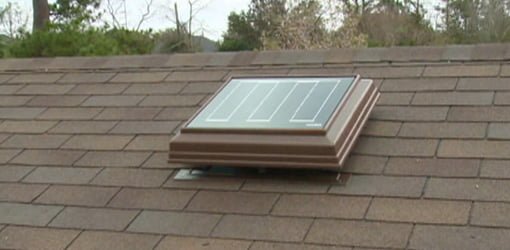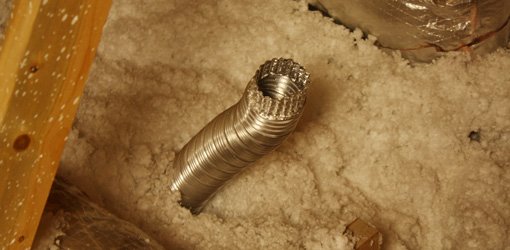The easiest way to find duct leaks is to inspect exposed ductwork and feel for air escaping at joints, seams, and connections while your HVAC system is running. You can also listen for whistling sounds, look for dust buildup around vents, and watch for uneven temperatures between rooms.
In older homes, 10% to 25% of your heated or cooled air may be leaking out of your ductwork, wasting energy and making your HVAC system work harder. These leaks can also drag in dust, allergens, and moisture—hurting indoor air quality and comfort.
In this guide, I’ll walk you through the most common signs of leaky ducts, how to track them down, and how to seal them with tools you can find at any hardware store. If you’ve got major duct issues, I’ll also explain when it’s time to call in a pro.
Signs of Leaky Ducts
Leaky ducts waste energy and make your home less comfortable.
Common signs include hot or cold spots. If certain rooms are always too warm in summer or too chilly in winter, your ducts may be leaking air before it reaches them. Another warning sign is a sudden spike in heating and cooling costs, which often mean your HVAC system is working harder to compensate for lost air.
Look for dust buildup around vents. Leaky ducts pull in attic, crawl space, or basement dust, which then circulates through your home. Also pay attention to moisture buildup on ductwork can indicate poor airflow or air escaping, which also increases the risk of mold growth.
If you hear air escaping from ducts when your HVAC is running, there’s likely a leak. Rooms near leaky ducts may feel breezy or experience extreme temperature differences between floors.
💡 Safety Concern: Leaks near your furnace can cause carbon monoxide backdrafts, allowing harmful gases to enter your home. If you suspect this, have your system inspected immediately.
How to Find Duct Leaks
Start by checking exposed ductwork in attics, basements, crawl spaces, and utility closets.
Feel for air movement by running your hand along duct seams and joints while the HVAC system is on. If you feel air escaping, there’s a leak. Listen for whistling sounds caused by air escaping from small gaps, especially near joints. Moisture on duct surfaces can signal poor airflow or leaks, which may also lead to mold growth, so check for condensation. And inspect where ducts connect to HVAC equipment – Leaks often occur where ducts attach to the furnace, air handler, or vents.
🔎 Pro Tip: Use a smoke pencil, incense stick, or tissue paper near duct seams. If the smoke or paper moves, there’s an air leak.
Pressure Testing
Before sealing leaks yourself, consider having an HVAC professional perform a pressure test to evaluate your entire duct system. This test detects hidden leaks in ducts running through walls, floors, and ceilings—areas you can’t inspect yourself.
Using a digital manometer, the technician measures airflow loss and pinpoints leaks. The technician covers all supply and return registers with plastic sheeting. A special fan forces air into the system, raising the pressure above normal levels.
💰 Cost: Expect to pay $200 to $400 for a standard home. Larger homes or complex ductwork may cost slightly more.
Where Duct Leaks Happen Most
Some parts of your duct system are more prone to leaks than others. Here’s where to check:
Where smaller ducts split off from the main trunk, metal fittings can loosen over time.
Sharp turns create airflow turbulence, which can weaken seals and cause leaks.
The connections between duct sections often develop gaps as tape and mastic degrade.
These metal boxes connect ducts to the furnace or air handler and can separate due to vibration and temperature changes.
If the duct isn’t securely attached to the vent opening, conditioned air leaks out before reaching the room.
DIY Leak Repairs
You can seal small leaks and loose fittings yourself using mastic sealant or metal foil tape—but skip regular duct tape, as it dries out and peels off over time.
How to Seal Duct Leaks:
- Clean the surface – Wipe down ducts to remove dust and debris for better adhesion.
- Use mastic for joints and gaps – Spread a thick layer over leaks and seams. It dries to a rubber-like seal that lasts for years.
- Apply metal foil tape for quick fixes – Press it firmly over small gaps, smoothing out wrinkles to create an airtight seal.
💡 Pro Tip: If sealing large gaps (over ¼ inch), use fiberglass mesh tape with mastic for extra strength.
Professional Duct Sealing
If your duct system has extensive leaks, hidden gaps, or damaged sections, it’s best to call an HVAC professional. Pros have the tools and expertise to seal hard-to-reach leaks and repair sections that DIY fixes can’t handle.
Pros often spray a specialized mastic inside duct seams. The sealant expands and hardens, creating an airtight, flexible bond. Accessible ducts may be re-taped or sealed on the outside for extra durability. Technicians will cut out the faulty portion and install new duct fittings in severely damaged sections.
Other HVAC Improvements
Sealing duct leaks is just one way to improve your home’s energy efficiency. Here are other upgrades that can enhance your HVAC system’s performance and reduce energy costs:
- Air balancing — Adjusting airflow to different rooms helps eliminate hot or cold spots and ensures even heating and cooling.
- Duct cleaning — While routine cleaning isn’t necessary, removing dust, pet hair, and debris can improve air quality after major renovations or mold issues.
- Duct insulation — Uninsulated ducts in attics, basements, or crawl spaces waste energy. Adding insulation prevents heat loss and improves efficiency.
- Duct modifications — If you’re remodeling, consider re-routing ducts to improve airflow and eliminate problem areas.
- Equipment maintenance — Keep your furnace, AC unit, and air handler in top shape by scheduling regular tune-ups and checking filters monthly.
- Programmable thermostat — Set different temperatures for when you’re home or away to reduce energy waste and lower your utility bills.
Impact on Energy Efficiency
Leaky ducts can drain 20–30% of your HVAC system’s efficiency, forcing your heating and cooling equipment to work harder. In some cases, up to 50% of conditioned air escapes before it even reaches your vents!
Did You Know
Leaky ducts can reduce your HVAC system efficiency by up to 30%.
Sealing ducts can cut heating and cooling costs by 10-20%, improving comfort and reducing system strain. The U.S. Department of Energy estimates the average home loses 20–30% of its heated or cooled air through duct leaks. Properly sealing and insulating ducts can save homeowners up to $140 per year on energy bills. A well-sealed system means your HVAC unit doesn’t have to work as hard, extending its lifespan and reducing maintenance costs.
Sealing Ducts for Cleaner Indoor Air
Beyond saving energy, sealing duct leaks also improves indoor air quality. Leaky ducts can pull in dust, pollen, mold spores, and outdoor pollutants, recirculating them through your home.
Sealing ducts prevents unfiltered air from entering your system, reducing allergens and airborne irritants. If you invest in professional duct cleaning, sealing leaks first prevents new dust and debris from getting in. Unsealed ducts can pull in air from crawl spaces, attics, or basements, introducing mold, mildew, and musty smells into your home.
Boost HVAC System Efficiency by Sealing Ducts
Leaky ducts force your HVAC system to work harder, leading to higher energy bills and premature wear on components. When conditioned air escapes, fans and blowers must compensate for the loss, reducing overall efficiency.
Sealed ducts improve airflow, so your furnace and AC don’t have to run as often. There will also be less wear and tear helps HVAC components last longer, delaying costly replacements. And a properly sealed system operates more efficiently, cutting down on wasted energy.
This site receives compensation from the companies featured in this listing, which may impact where and how products appear. This listing doesn’t feature all companies, products, or offers that may be available.
So, Is It Worth Fixing Duct Leaks?
Sealing leaky ducts provides one of the highest returns on investment for homeowners seeking energy savings. The job isn’t prohibitively expensive, especially relative to the resulting long-term savings on energy bills. Few home improvements offer a better payback.
Correcting duct leaks and insulation issues pays for itself in reduced heating and cooling costs within two years, and continues providing savings year after year after that. Sealing duct systems enhances comfort, indoor air quality, and longevity of HVAC equipment. For most homeowners, repairing leaky ductwork is a wise investment.
FAQs About Duct Leaks
If you’re tackling minor leaks with HVAC foil tape and mastic sealant, you can expect to spend $50 or less on materials. However, professional duct sealing—where an HVAC technician tests and seals leaks—costs between $450 and $750, depending on the home’s size and leak severity. If extensive repairs or aeroseal technology (a high-tech internal sealing method) are needed, costs can exceed $1,000.
Leaky ducts aren’t always obvious, but you might notice:
- Uneven temperatures between rooms or floors.
- High energy bills that don’t match your usage.
- Dusty or dirty vents, which can mean leaks are pulling in attic or crawl space air.
- Whistling sounds coming from duct joints.
- Condensation on ducts or dirty spots on insulation, showing air is escaping.
If you’re unsure, a professional duct leakage test can measure airflow loss and pinpoint leaks.
Yes. Even newly installed ducts often have small gaps at joints and seams that let air escape. Builders rarely seal ducts as thoroughly as they should. Applying mastic sealant ensures an airtight system, especially for ducts running through attics, basements, or crawl spaces. If your new ducts are in unconditioned spaces, adding duct insulation helps prevent heat loss and improves efficiency.
In most cases, no. Routine duct cleaning isn’t necessary unless you see visible mold growth inside the ducts. Or if you’ve recently remodeled, stirring up dust and debris. If you own pets and notice excessive hair and dander in vents, it might be worth cleaning them.
Instead of frequent duct cleaning, focus on changing your HVAC filter every 1-3 months to maintain air quality.
Ironically, standard duct tape is terrible for sealing ducts. Its adhesive dries out quickly, causing it to peel away. Instead, use either HVAC-rated foil tape for a quick, durable seal or mastic sealant for a long-lasting, flexible bond.
Both options create an airtight seal that lasts years longer than regular duct tape.
A professional can seal accessible ductwork in a single day. However, hard-to-reach ducts inside walls or tight crawl spaces may take two or three days. If you’re DIY-sealing exposed ducts, you can finish in a few hours, depending on the number of leaks.










